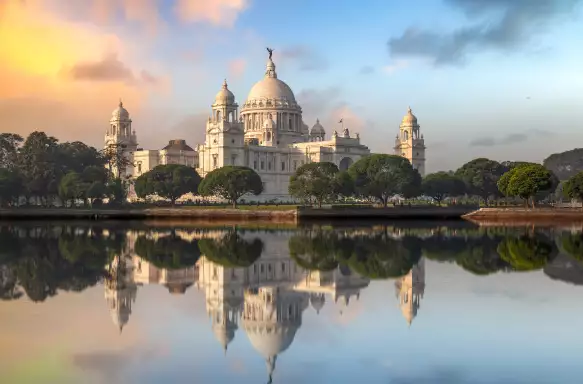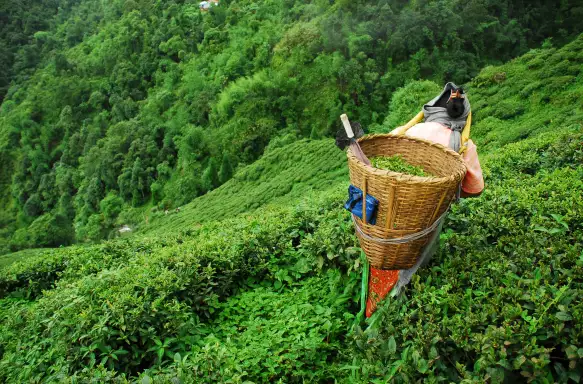Eastern Highlights – Darjeeling & Bhutan
From colonial Kolkata and tea-scented Darjeeling to sacred monasteries and mountain passes, discover a different side of India and uncover the spiritual serenity of Bhutan.
Step into a world of contrasts on this unique journey through Eastern India and Bhutan. Begin in Kolkata, where the legacy of British India and colourful street life combine to create a feast for the senses. Then enjoy a taste of Himalayan charm, as we ascend to Darjeeling, visiting tea estates and riding on the UNESCO-listed Toy Train. Crossing into Bhutan, we discover a land of sacred monasteries, fluttering prayer flags, and dramatic mountain landscapes — from the cliffside Tiger’s Nest to the serene dzongs of Thimphu and Punakha.
The holiday is ideal for curious travellers seeking a deeper, more adventurous cultural experience in South Asia — perfect for those who have already explored India's Golden Triangle and wish to discover more.
At a glance
Highlights
- Step into the world of tea at the Glenburn Tea Estate for a guided tour to find out how the humble tea leaf is transformed into the perfect cup before lunch in this scenic locale.
- Discover the sights of Kolkata on a guided tour, including famous sights like Dalhousie Square - or 'BBD Bagh' as it’s known to locals - the Victoria Memorial, and the vibrant Mullik Ghat flower market and visit the final resting place of Mother Teresa.
- Ride the Darjeeling Himalayan Railway - affectionally known as the Toy Train - transformed north Bengal's sleepy hill economy, giving rise to new villages, tea estates and residential schools.
- Visit to two historic dzongs: Tashichho Dzong, one of Bhutan’s most iconic landmarks and a seat of power; and Punakha Dzong, considered one of the most beautiful dzongs in the country, where all of the country’s kings have been crowned.
- Dine at the elegant Glenburn Penthouse, a beautifully restored colonial-style residence with views over the city.
- Discover the fascinating story of Bengal in an illuminating guest lecture that brings history to life.
- Hear from local experts about Bhutan’s Gross National Happiness policy and find out why they prioritise well-being over purely economic growth.
- Hike to the legendary Tiger’s Nest Monastery, which clings to the cliff face, and enjoy a guided tour of this serene complex.
Your itinerary
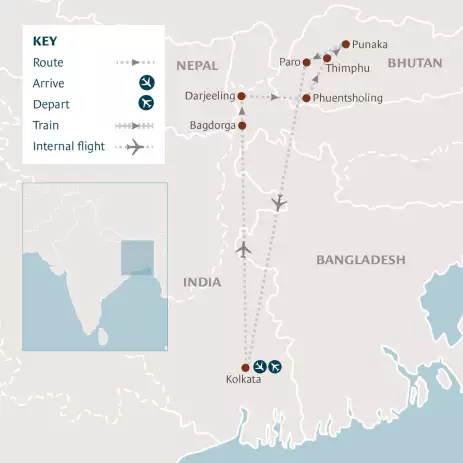
Depart UK
Head to the airport for your flight to Kolkata.
Arrive at the airport for your flight to Kolkata.
Arrival in Kolkata
Arrive in Kolkata this afternoon, where you'll be met by a member of our team and transferred to our hotel.

Stay at ITC Sonar Kolkata
Touching down in India this afternoon, we transfer to the heart of the vibrant city of Kolkata (formerly Calcutta) — a place where colonial charm meets rich culture. After settling into our comfortable hotel for a two-night stay, there's time to relax and refresh before we head out for the perfect introduction to this region.
Tonight, we'll dine at the elegant Glenburn Penthouse, a beautifully restored colonial-style residence with sweeping views over the city, including the Victoria Memorial — nicknamed 'Taj of the Raj', thanks to its impressive white marble, gigantic dome and square design. Here, we'll enjoy a delicious welcome dinner, followed by an illuminating guest lecture that brings to life the story of Bengal, a land of poets, revolutionaries and timeless traditions. It’s the perfect introduction to the spirit of eastern India.
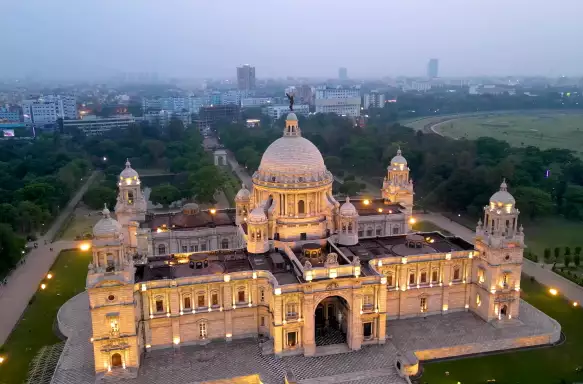
Kolkata
Discover the sights of Kolkata on a guided tour of the city.

Kolkata, India's third-largest city, is a festival of the human experience. Its chaotic patchwork of colonial architecture is decorated with garlands of marigolds and infused with the scent of Bengal street food. Today we'll dive into its rich tapestry on a sightseeing tour, led by an expert local guide who'll share fascinating insights into daily life in the city.
We'll begin in the heart of old Kolkata with a guided walk around Dalhousie Square, or 'BBD Bagh', as the locals call it. Once the nerve centre for the East India Company's most imposing buildings, it holds echoes of the Empire at its peak. Our tour will walk you through its highlights, including the stately General Post Office — a masterpiece of Indo-Saracenic and Neoclassical styles, with a magnificent dome — and a visit inside the serene St John's Parish Church, one of the city’s oldest Anglican landmarks.
After an included lunch, we’ll take a closer look at the Victoria Memorial, a gleaming white-marble monument often dubbed the 'Taj of the Raj'. With its sweeping lawns and vast white marble dome, it commemorates the death of Queen Victoria and serves as a grand reminder of Kolkata's colonial past. Inside, the building holds a collection of art and books, including beautifully illustrated works by William Shakespeare on display in 25 galleries.
Near the southeast end of Howrah Bridge — one of the longest cantilever bridges in the world — is one of the city's most colourful and captivating corners. The Mullik Ghat flower market is a feast of colour and fragrance. Unlike the UK's cut flowers, stalls here sell fresh flower heads, flower decorations, and garlands in every hue imaginable. Marigolds in brilliant orange and yellow, delicate roses and exotic orchids are piled high, destined for temples, weddings and sacred rituals.
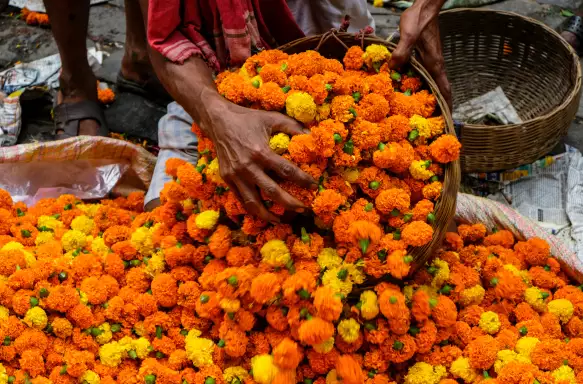
Kolkata to Darjeeling
Leave Kolkata and travel to the picturesque hill station, Darjeeling, enjoying the scenery along the winding mountain roads.

Stay at Elgin Hotel Darjeeling
Darjeeling
Today we bid goodbye to Kolkata and take a short internal flight to Bagdogra in the Darjeeling district of West Bengal. From here, we'll begin our journey into the hills of the Eastern Himalayas. The scenery changes from tropical plains to emerald-green slopes carpeted with tea gardens and fluttering prayer flags as we travel along winding mountain roads.
Climbing into the cool, misty height, our destination is one of the most beautiful hill stations in India, Darjeeling, 6,700 feet above sea level. Once the summer retreat for British Colonial officers, Darjeeling is steeped in old-world elegance and quiet grandeur. Before we reach our hotel, we'll see Victorian architecture, Buddhist monasteries and sweeping views of snow-capped peaks.
Check into our hotel for the next three nights and settle in. Tomorrow, we’ll begin exploring in earnest but for now, simply arriving feels like stepping into another world.
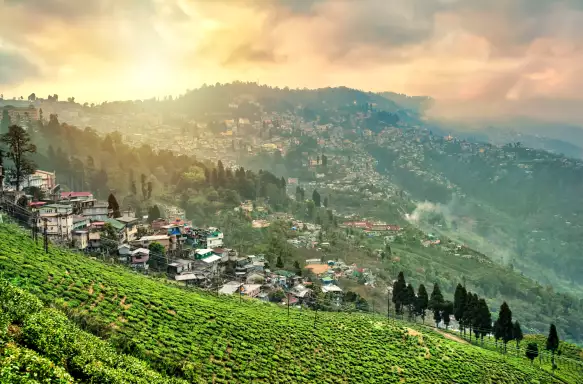
Darjeeling
Watch the sunrise of the Himalayas before visiting Ghum on the Toy Train. Return to Darjeeling to enjoy a guided heritage walk.

Sherpa village
Early risers can enjoy a magical excursion to a nearby Sherpa village, where we'll watch the sun rise over the Himalayas. When the first golden light spills across the peaks, the silhouette of Kanchenjunga may reveal itself in all its glory — a moment of quiet awe that any budding photograph will want to capture.
Darjeeling Himalayan Railway & heritage walk
Returning to the hotel for a well-earned breakfast, our day exploring Darjeeling begins in earnest with a ride aboard a marvel of 19th-century engineering. Designed and built by the British in 1880, the Darjeeling Himalayan Railway, affectionally known as the Toy Train, transformed north Bengal's sleepy hill economy, giving rise to new villages, tea estates and residential schools. Today, it retains most of its original charm and was Asia's first 'industrial heritage' site to be inscribed on UNESCO's World Heritage List.
As the miniature steam engine chugs its way up the steep gradients and seemingly impossible curves, we pass through breathtaking landscapes, tea gardens and hillside hamlets. A highlight of the journey is the Batasia Loop, a spiralling section of track that offers panoramic views of Darjeeling town and the majestic Kanchenjunga range.
After free time for lunch, we'll set out on a heritage walk to discover Darjeeling's colonial heritage. From the Mall Road — a scenic promenade lined with old-world shops, bookstalls, and charming cafés — to St Andrew's Church and the nearby Planters’ Club, echoes of the past linger in every cobbled lane. As we pause to enjoy vistas of the valley below and breathe in the crisp mountain air, we think you'll agree that Darjeeling lives up to its moniker, the "Queen of the Hills".
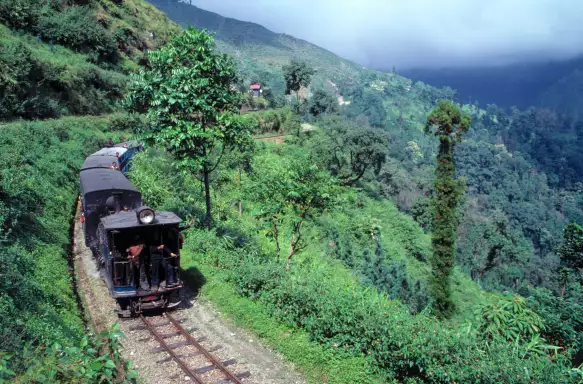
Darjeeling Tea Estate
Step into the world of tea with a visit to the Glenburn Tea Estate for a tour and tasting or the UK’s most popular drink.

After breakfasting this morning, we’ll take a scenic drive through the hills to the Glenburn Tea Estate, a tranquil haven nestled on the banks of the Rangeet River, in the shadow of the Kanchenjunga Mountain range.
This family-run estate, passed down through generations of expert tea planters, offers a fascinating glimpse into the world of tea. We'll explore the estate with a guide, wandering through the lush gardens and working factories to find out how the humble tea leaf is transformed into the perfect cup. A guided tea-tasting session introduces us to the Glenburn Estate's range of black, green, oolong and white teas — each with a different aroma, flavour, appearance and story. By the time we leave, you'll be a tea connoisseur!
Our visit ends with lunch on the estate, after which we'll return to our hotel and spend the rest of the day at leisure.
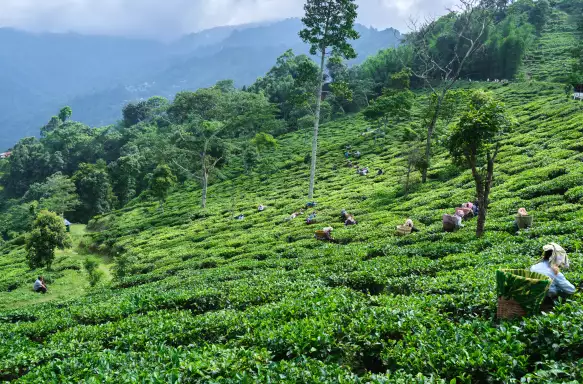
Darjeeling to Phuentsholing
Leave India behind this morning as we travel across the border to Bhutan.

Stay at Druk Hotel
The journey is a long one, but it’s the only way to cross into Bhutan — and it’s anything but dull. We’ll wind our way through classic Indian villages and ever-changing landscapes, arriving at the border in the early afternoon. After a quick hello to both Indian and Bhutanese immigration, we continue to Phuentsholing.
The difference is unmistakable. India is a whirlwind of colour and sound; Bhutan, by contrast, greets us with calm and quiet. Here, it’s actually illegal to toot your own horn without good reason — you won’t find a single traffic light in the entire country.
After time to settle into our hotel, we set out to visit the Kharbandi Goempa Monastery. Perched on a hillside overlooking the plains of India, this sacred site was founded by the Royal Grandmother, Ashi Phuntsho Choden, and is one of the oldest Buddhist temples in Bhutan.
Inside, the monastery is a treasure trove of spiritual artistry — from beautifully crafted statues to vivid murals, and intricate paintings that depict the life and teachings of the Buddha. Among its most striking features are a towering 10-foot statue of Guru Padmasambhava, along with life-size representations of other revered deities.
Outside, the peaceful tropical gardens invite quiet reflection. Dotted with eight whitewashed chortens (stupas) symbolising key events in the Buddha’s life, the grounds are also adorned with fluttering prayer flags, enormous prayer wheels, and traditional Bhutanese architecture — all set against a backdrop of lush greenery and mountain air.
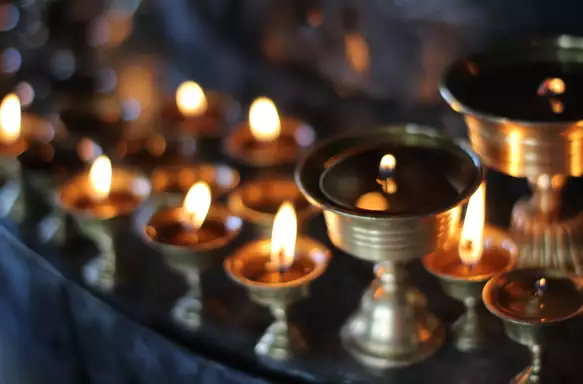
Phuentsholing to Thimphu
Travel to Thimphu, where we visit Thimpu Chorten, Tashichho Dzong, and listen to an expert talk on Bhutan’s Gross National Happiness (GNH).

Stay at Le Meridien Thimphu
This morning, we set off for Thimphu, arriving at our hotel in time for lunch.
Thimpu Chorten
After time to settle in, we will visit one of Thimphu's most noticeable landmarks - Thimphu Chorten. Located in the southern central part of the city, a place of worship and a monument to Bhutan’s third king, Jigme Dorji Wangchuck, revered as the father of modern Bhutan. Adorned with intricate carvings, golden spires, and vibrant murals and, inside, you’ll find statues and paintings that honour the king’s legacy and reflect the deep roots of Buddhist culture.
Tashichho Dzong
This afternoon we visit one of Bhutan’s most iconic landmarks, Tashichho Dzong, a grand dzong (fortress-monastery) that has stood for centuries as both a spiritual sanctuary and a seat of power. Located to the north of Thimphu, on the west bank of the Wang Chhu River, it is one of the city's most famous sights.
Originally established in the 13th century, the dzong has been rebuilt several times over the centuries, due to fires and an earthquake, yet its grand whitewashed walls and red and gold tiered towers are a striking symbol of Bhutanese resilience and craftsmanship. Through the southern gates is the administrative centre of the small mountain country, housing the throne room and offices of the king (though it's not open to the public). We’ll enter through the northern gate, which opens into the monastic quarters - the summer residence of Bhutan’s central monk body.
Inside, we pass murals of guardian kings and revered figures like Drukpa Kunley, before stepping into a vast courtyard dominated by a utse (central tower), which houses sacred relics, including the funeral chorten of the 69th Je Khenpo. Nearby we'll see the Lhakhang Sarp chapel and the dukhang (assembly hall), home to a large Buddha statue and royal thrones.
Surrounding the dzong are further symbols of Bhutan's heritage: a traditional cantilever bridge to the northeast, the king’s residence to the southeast and the National Assembly across the river. West of the dzong is the Neykhang Lhakhang which houses protective deities. Its religious significance means it is closed to visitors, but it certainly adds to the spiritual gravity of the site.
Expert talk
Returning to our hotel before dinner this evening, meet an expert local to find out more about Bhutan's Gross National Happiness policy, which prioritises well-being over purely economic growth and its influence on public policy.
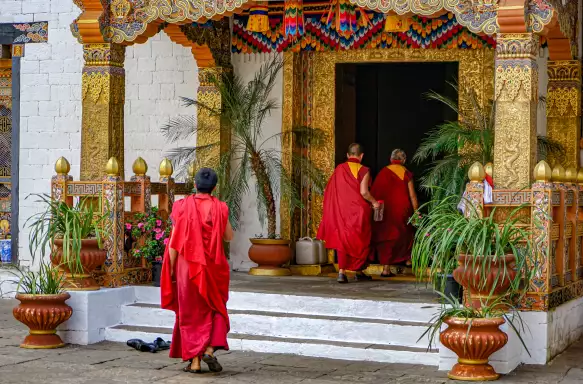
Punakha
Walk in the footsteps of kings as you explore one of the most beautiful dzongs in the country, Punakha.

Punakha Dzong
This morning, we leave the capital behind and journey over the scenic Dochu La Pass, where, on a clear day, the snow-capped peaks of the eastern Himalayas stretch across the horizon. Descending into the lush Punakha Valley, we arrive at one of Bhutan’s most breathtaking landmarks — the Punakha Dzong.
Often considered the most beautiful dzong in the country, Punakha Dzong is steeped in history and grandeur. It was here that all of Bhutan’s kings have been crowned, and its architecture is a striking example of traditional Bhutanese design - with high, arched windows, grand wooden doors, and tiered, flared roofs that seem to float above the whitewashed walls.
Its serene location at the confluence of two rivers gives it unparalleled natural beauty and spiritual calm. Inside, peaceful courtyards are adorned with intricate Buddhist murals in soft yet vibrant hues, while saffron-robed monks move quietly through the corridors, continuing the rhythms of monastic life.
Depending on the season, we’ll take a gentle stroll through fields of rice, wheat or vegetables - an everchanging patchwork that gives us a real taste of rural life. Our walk leads us to Chimi Lhakhang, a temple famous for its blessings of fertility and a place where local legend and daily life intertwine.
After our visit, we'll return to our hotel in Thimphu and spend the rest of the day at leisure.
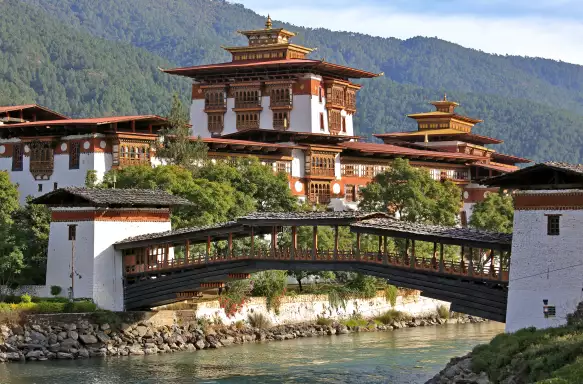
Thimphu & Paro
Discover the sights of Thimphu, including Buddha Dordenma, and explore Bhutan's rich heritage of craftsmanship.

Stay at Le Meridien Paro
Buddha Dordenma Statue
Our day begins at one of Thimphu's most noticeable landmarks. One of the largest Buddha stupas in the world at 177 feet, and gilded entirely in gold the Buddha Dordenma Statue is visible from everywhere in Thimphu — you can’t miss it. Built from 2006 to 2015, its construction fulfilled an ancient prophecy, bringing peace and prosperity to the entire world.
Textile Museum
Next, we'll enjoy a visit to the Royal Textile Museum to see its fascinating display of ancient and modern textiles in exhibits that explore the rich traditions of Bhutan's national arts of thagzo (weaving) and tshemzo (embroidery). Highlights include wedding clothes worn by the fourth king and his four wives — a stark contrast to the everyday attire worn by Bhutanese men and women, also on display.
Craft Bazaar
Sticking to the theme of Bhutanese craftsmanship, our last visit is to the Craft Bazaar, located in Norzin Lam, one of Thimphu’s main thoroughfares. With around 80 colourful stalls and shops, this open-air market is a celebration of the country's dedication to preserving its traditional art forms while catering to contemporary market demands. From handwoven scarves and carved masks to handmade paper and traditional jewellery, it’s the ideal place to find a meaningful souvenir and support local artisans.
Travel to Paro
After much of the day spent exploring Thimphu, we head off to Paro for a three-night stay.
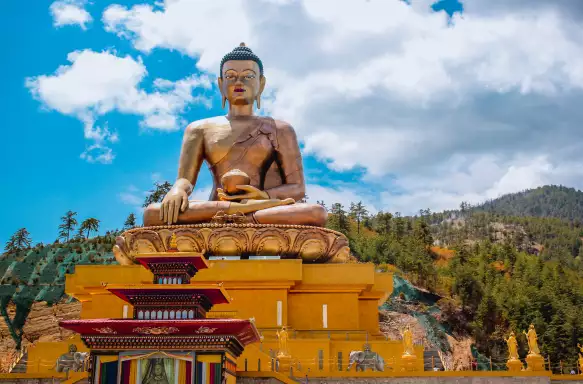
Paro
Learn more about how magic and science are inseparable in Bhutan at the National Museum and peruse the stalls of a local market.

Our exploration of Paro begins perched high above the city, at the Ta Dzong. Originally built to protect the Rinpung Dzong from the unceasing assaults from Tibet and India, it is now a national museum housing more than 3,000 artifacts dating back 1,500 years. Learn more about how magic and science are inseparable in Bhutan, see ancient relics discovered by Bhutan’s treasure finders and marvel at rare treasures, including a stone egg allegedly laid by a mule and a ritual dagger said to belong to the protector Dorje Lekpa.
After time to explore, we'll head to a local market for an introduction to some of Bhutan's unique local produce — squares of dried jellied cow skin known as khoo (a local snack) to fresh husky betel nut (a fruit that looks like an orange egg), imported from India. Then, after whetting your appetite, we'll head to a traditional farmhouse for an authentic Bhutanese lunch.
The rest of the afternoon is at leisure as we head back to our hotel in Paro. Take this time to unwind, soak in the serene surroundings and recharge — tomorrow’s hike to the iconic Tiger’s Nest awaits.
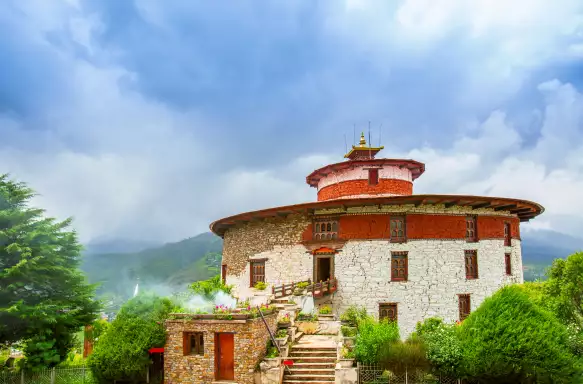
Tiger’s Nest Monastery
Hike to the Tiger’s Nest Monastery, a sacred Buddhist site, stopping for lunch midway.

Enjoy a real highlight of the holiday today, a pilgrimage to the most sacred Buddhist site in Bhutan, Taktsang Goemba - better known as the Tiger's Nest Monastery. Clinging dramatically to a cliff overlooking the Paro Valley, this legendary monastery marks the spot where it's said Padmasambhava, the 8th-century Indian sage who brought Buddhism to Bhutan, meditated after flying here on the back of a tigress.
Reaching the monastery is an adventure in itself. The only way up is on foot via a steep hike up a rough but well-trodden mountain path for around two and half hours. As we wind through pine forest and prayer-lined trails, we'll gain about 550m (1,800 ft) in elevation. Midway to the top, we'll pause for a rest at the café while enjoying the scenic views.
As we continue the final zigzagging ascent along the cliff's contours, the full majesty of the monastery unveils itself before you — a vision that feels almost otherworldly.
Upon arrival, we begin our guided tour of the monastery complex, including the sacred Drubkhang cave, where Guru Rinpoche is said to have meditated for three months. The inner sanctum, sealed behind gilded doors, is surrounded by vivid murals of his eight manifestations and powerful deities like Dorje Drolo and Tseringma. As we ascend through chapels and lhakhangs, we’ll encounter sacred relics, hidden carvings, a holy spring and even descend into the original Tiger’s Nest cave via steep wooden ladders carved into the cliffside.
Top tip: Near the entrance, look for the relic stone - Bhutanese pilgrims stand at a marked spot, close their eyes and try to put their thumb into a small hole in the rock said to conceal a treasure hidden by Guru Rinpoche. It’s a playful yet spiritual karmic test and a memorable way to end this extraordinary experience before we make our way back down the mountainside.
As we descend from the monastery, we pause at the café for a well-earned lunch before continuing our journey back to the hotel. The rest of the day is yours to enjoy at leisure, whether you choose to relax, reflect or simply take in the tranquil surroundings.
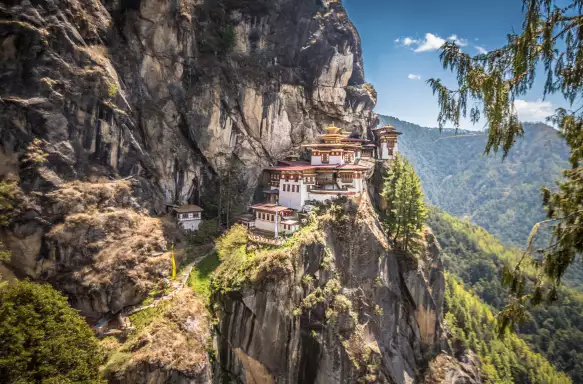
Paro to Kolkata
Travel to Kolkata where we visit the final resting place of Mother Teresa and artisan quarter of Kumartuli.

Stay at ITC Sonar Kolkata
Kolkata
On arrival in Kolkata, we will follow in the footsteps of countless Christan pilgrims to a place of quiet reverence — the Missionaries of Charity’s 'Motherhouse'. This is the final resting place of Mother Teresa. In the adjacent museum, simple yet powerful relics of her life are on display. Upstairs is the room where she worked and slept from 1953 to 1997, her modest room remains just as it was — a small, sunlit space where she lived, worked and prayed from 1953 until her passing in 1997. It’s a moving tribute to a life of compassion and service.
In the winding alleys of Kumartuli, the artisan quarter, time seems to slow and silence carries the scent of clay. We wander through a world shaped by devotion. Here, master artisans coax divinity from earth, their hands dancing over damp clay as gods and goddesses slowly awaken beneath their touch.
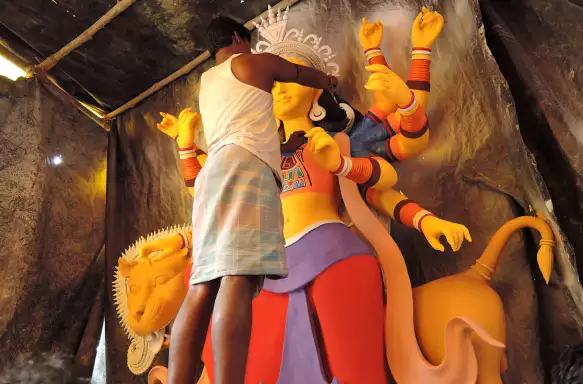
Departure
Depart for the airport for our return flight home.
Hand-picked hotels
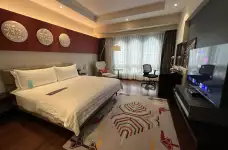
Le Meridien Thimphu
Thimphu, Bhutan
Chosen for its convenient location, the Le Meridien offers a comfortable stay in Thimphu.
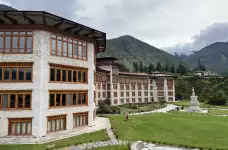
Le Meridien Paro
Paro, Bhutan
Chosen for its scenic location on the banks of the Paro River.
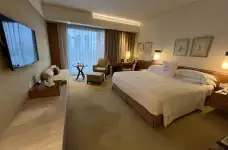
ITC Sonar Kolkata
Kolkata, West Bengal, India
Chosen for its peaceful gardens and tranquil pond—an oasis of calm after a day’s exploring.
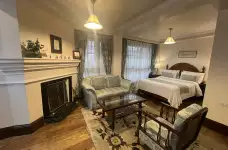
Elgin Hotel Darjeeling
Darjeeling, West Bengal, India
Chosen for comfort and its incredible setting with views over the hills and mountains.
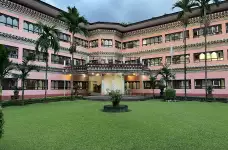
Travel connections
| Arrival airport | First hotel location | Transfer time | Final hotel location | Departure airport | Transfer time |
|---|---|---|---|---|---|
| Kolkata | Kolkata | 45 mins | Kolkata | Kolkata | 45 mins |
FAQs
The cost of a 30-day tourist e-visa is US$10 if your date of entry if from April to June, or US$25 if your date of entry is from July to March.
You must apply for your e-visa no more than 30 days before you’re due to enter India. The application takes around three working days. We recommend you apply for your e-visa two to three weeks before your arrival date in India.
Once your visa is approved, you have 30 days to enter India. Upon entry, the visa is then valid for 30 days, and it is a double entry visa.
During the application, you’ll need to submit a passport-sized photo in JPEG format and a scanned copy of your passport in PDF format.
Apply online at indianvisaonline.gov.in/evisa/
The deposit for this holiday is £500pp, then the remaining balance of the holiday is due a minimum of 90 days before you depart.
The price of this holiday is per person, based on two people sharing a twin room with single rooms available at the relevant supplement. Price includes:
- 12 included experiences
- Daily breakfast, plus 7 lunches and 8 dinners
- 13 nights in four-star hand-picked hotels
- Return flights and transfers
- All additional taxes
- The services of a Riviera Travel Tour Manager
- Average group size of 22 guests
- A local guide on most guided tours
- Governmental Sustainable Development Fee for Bhutan
- Bhutan Visa Fee
Currency: Indian Rupee, Bhutanese Ngultrum
Flight Time: Approx. 8 hrs 30 mins
Language: Hindi, Dzongkha
Time Zone: GMT+5.5, GMT+6
Country: India, Bhutan
Availability
Selecting price display and sort by options will update the results displayed below automatically.
We've found you 8 holidays
Choose your date, departure point and the type of tour. Accommodation options will be shown at the next step.
-
Signature Tour
Signature Small Group Tours of max 25 people and added extras
| Tour style | Date | Departs | Departing from | Accommodation | Price from | Call to action |
|---|---|---|---|---|---|---|
|
Signature Tour
|
13 Jan 2027 | TBC |
|
ITC Sonar Kolkata | £4,829 pp | Book now |
Outbound:
|
Inbound:
|
|||||
|
Signature Tour
|
17 Feb 2027 | TBC |
|
ITC Sonar Kolkata | £4,829 pp | Book now |
Outbound:
|
Inbound:
|
|||||
|
Signature Tour
|
17 Mar 2027 | TBC |
|
ITC Sonar Kolkata | £4,829 pp | Book now |
Outbound:
|
Inbound:
|
|||||
|
Signature Tour
|
07 Apr 2027 | TBC |
|
ITC Sonar Kolkata | £4,829 pp | Book now |
Outbound:
|
Inbound:
|
|||||
|
Signature Tour
|
15 Sep 2027 | TBC |
|
ITC Sonar Kolkata | £4,499 pp | Book now |
Outbound:
|
Inbound:
|
|||||
|
Signature Tour
|
11 Oct 2027 | TBC |
|
ITC Sonar Kolkata | £4,829 pp | Book now |
Outbound:
|
Inbound:
|
|||||
|
Signature Tour
|
20 Oct 2027 | TBC |
|
ITC Sonar Kolkata | £4,346 pp | Book now |
Outbound:
|
Inbound:
|
|||||
|
Signature Tour
|
10 Nov 2027 | TBC |
|
ITC Sonar Kolkata | £4,829 pp | Book now |
Outbound:
|
Inbound:
|
|||||
